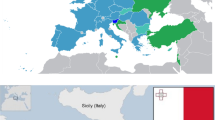Abstract
In this paper, we describe a compact, low cost, fast turn-around-time technique used at the Air Force Research Laboratory to study hypervelocity debris impact effects on spacecraft structures and components. The technique described was used to study debris effects in the areas of: shock physics, debris-produced contamination, chemical analyses of the impact ejecta and debris initiated spacecraft discharge. Examples of research results obtained with the technique are presented and illustrate problems encountered in the field of space debris effects on spacecraft.
Similar content being viewed by others
References
J.B. Anderson and R.P. Andres. In Proceedings of the Fifth International Symposium on Rarefield Gas Dynamics, University of Oxford, UK, 1966, found in Rarefield Gas Dynamics, Vol. II. Academic Press, London, New York, pages 1317–1336, 1967.
L.M. Barker and R.E. Hollenbach. Laser Interferometer for Measuring High Velocities of Any Reflecting Surface, Journal of Applied Physics, 43: 4669–4675, 1972.
R.A. Buckingham and J. Corner. Proceedings of the Royal Society (London) A 189: 118, 1947.
J.P. Catani. Electrostatic Discharges and Spacecraft Anomalies. In Proceedings of the 7th Spacecraft Charging Technology Conference, ESA-ESTEC, Noordwijk, Netherlands, April 23–27 The Natural Space Environment: Effects on Spacecraft,NASA Reference Publication, 1350, November, 1994.
D.J. Kessler, R.C. Reynolds and P.D. Anz-Meador. Orbital Debris Environment for Spacecraft Designed to Operate in Low Earth Orbit. NASA-TM 100471, September, 1988.
T.R. King and J.H. Shively. Non-Linear Hugoniots, American Institute of Physics. In Conference Proceedings, 370, AIP Press, pages 47–50, 1996.
T.R. King and J.H. Shively. Shock-Data Constraints on Interatomic Potentials for Condensed Matter. International Journal of Impact Engineering, 23: 455–466, 1999.
C.A. Kitchen, A.A. Dollery, K. Mullaney and K. Bogus. Teflon Bonding of Solar Assemblies Using Pilkington CMZ and CMG Cover Glass. AIAA paper 94-3969, pages 257–262, 1994.
H. Lam and J. Hruska. Magnetic Signatures for Satellite Anomalies. Journal of Spacecraft, 28: 93–99, 1991.
R.D. Leach and M.B. Alexander.Failures and Anomalies Attributed to Spacecraft Charging.NASAReference Publication 1375, August 1995.
J. Lennard-Jones. The Equation of State of a Gas. Proceedings of the Cambridge Philosophical Society, 22: 105, 1931.
L. Levy, D. Sarrail, V. Viel, E. Amorim, G. Serrot and K. Bogus. Secondary Arc on Solar Arrays: Occurrence, Thresholds, Characteristics and Induced Damage. Proceedings of the 7th Spacecraft Charging Technology Conference, ESA-ESTEC, Noordwijk, Netherlands, April 23–27, 2001.
K.A. Lincoln and A.M. Covington. Dynamic Sampling of Laser Induced Plasmas by Mass Spectrometry. International Journal of Mass Spectrometry and Ion Proceedings, 16: 191, 1975.
NASA SSP 30426, paragraph 3.4.3, Space Station External Contamination Control Requirements, NASA, 1994.
J.C. Mandeville. Cosmic Dust and Orbital Debris: Collection on MIR Space Station. Advances in Space Research, 11(12): 93–96, 1991.
J.A.M. McDonnell, S.P. Deshpande, S.F. Green, P.J. Newman, M.T. Paley, P.R. Ratcliff, T.J. Stevenson and K. Sullivan, First Results of Particle Impacts and Foil Perforations on LDEF. Advances in Space Research, 11(12): 109–114, 1991.
D.L. Paisley, N.I. Montoya, D.B. Stahl, I.A. Garcia and W.F. Hensing. Ultra and High Speed Photography, Videography, Photonics, and Velocimetry. Proceedings SPIE, 1346: 172–178, 1990.
G.D. Preston. Nature, 142: 570, 1938.
M.H. Rice, R.G. McQueen and I.M. Walsh. Solid State Physics, 6: 1958.
M. Rival and J.C. M andeville. Space Debris, 1: 45, 1999.
F.M. Rose. Hypervelocity Impact on Solar Cells.NASATechnical Report,NASA-CR-192444, January, 1993.
R. Roybal, C. Miglionico, C. Stein and K.A. Lincoln. Laser Ablation Study of Spacecraft Materials by Time of Flight Mass Spectrometry. USAF Phillips Laboratory Report PL-TR-92-1074, 1995a.
R. Roybal, C. Stein, C. Miglionico and J. Shively. Laboratory Simulation of Hypervelocity Debris. International Journal of Impact Engineering, 17: 707–718, 1995b.
R. Roybal and P. Tlomak. Hypervelocity Space Debris Testing. Proceedings of the AIAA Defense and Space Programs Conference, Huntsville, AL, September 23–25, 1997.
R. Roybal, P. Tlomak, C. Stein and H. Stokes. Simulated Space Debris Impact Experiments on Toughened Laminated Thin Solar Cell Cover Glass. International Journal of Impact Engineering, 23: 811–821, 1999.
E. Schneider. Micrometeorite Impact on Solar Panels. Proceedings of the 5th European Symposium: Photovoltaic Generators in Space, Scheveningen, The Netherlands, September 30, 1986.
W.P. Schonberg. Characterizing Secondary Debris Impact Ejecta. NASA/CR 1999-209561, August 1999.
J. Shively and R. Roybal. Chemical and Structural Effects Caused by Hypervelocity Impacts on Polysulfone-Graphite Reinforced Composite and its Resin. US Air Force Phillips Laboratory Report PL-TR-92-1076, 1993.
J. Shively, C. Stein and R. Robertson. An Equation of State for Shock in Homogeneous Materials and Comparison with Data. US Air Force Phillips Laboratory Publication PL-TR-92-1060, 12, April, 1993.
C. Stein. Hypervelocity Debris Initiated Spacecraft Discharging. Proceedings of the 7th Spacecraft Charging Technology Conference, ESA-ESTEC, Noordwijk, Netherlands, April 23–27, 2001.
C. Stein. Shock Induced Precipitation in Aluminum-3.85% Copper Alloys. Scripa Metallurgica, 9: 67–70, 1975.
K. Uesugi. Collisions in Space: A Retrospective Overview of ISAS Studies. Advances in Space Research, 11(12): 19–27, 1991.
J.E. Wahlund, L.J. Wedin, A.I. Eriksson, B. Holback and L. Andersson. Analysis of Freja Charging Events: Charging Events Identification and Case Study. In Study of Plasma and Energetic Environments and Effects.WP 110 Technical Note, SPEE-WP110-TN version 2.0, ESA contract 11974/96/NL/JG(SC). March 10, 1999.
E.M. Wooldridge. Initial Contamination Control Consideration for the Next Generation Space Telescope. 7th International Symposium on Materials in a Space Environment, Toulouse, France, 128, 1997.
G. Wrenn and A.J. Sims. Spacecraft Charging in Geosynchronous Orbit. NATO Advanced Institute Study Proceedings, Pitlochry, Scotland, July 1991.
Author information
Authors and Affiliations
Rights and permissions
About this article
Cite this article
Stein, C., Roybal, R., Tlomak, P. et al. A Review of Hypervelocity Debris Testing at the Air Force Research Laboratory. Space Debris 2, 331–356 (2000). https://doi.org/10.1023/B:SDEB.0000030024.23336.f5
Issue Date:
DOI: https://doi.org/10.1023/B:SDEB.0000030024.23336.f5




